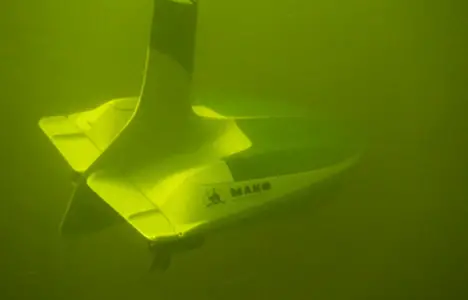Breaking news
MAKO Penguin UUV / USV System in trials with Russia's Secret Services FSB.
| 2016
|
|
|||
 The Penguin USV/UUV. Photo: Scientific and Industrial Group "MAKO" |
|||
|
|
|||
|
When on the surface, the 1.5-m-long Penguin looks similar to an overturned surfing board, which 80-cm tailfin is not in the water, but sticks up in the air. The submersible travels at a speed of 12 knots - just over 20 km/h - and dives to 500 m in automatic mode. It retains its self-contained operating capability for 6 h.
The Penguin carries the Gidra mini-sonar, which sensors are marginally larger than a ballpoint pen. The Gidra feeds quality imagery of the sea floor to the operator from hundreds of meters away and images of hydraulic work walls or ship hulls from tens of meters away," Vladimir Trusilov, director general of the Ekran Company developing unique sonars, told the Izvestia. "The footage’s quality enables the operator to correctly identify the object in his field of view and take appropriate measures." According to expert Alexander Mozgovoi, controlling the underwater situation near dams, hydroelectric power station, bridges and naval bases is a key security mission. "The experience drawn from local wars and conflicts has shown that there are many ways to emplace underwater mines. Aircraft, commercial surface vessels, submarines and naval commandos can be used for this purpose," Mozgovoi says. "A most graphic example is the tragic sinking of the Novorossiisk battleship on the roadstead of Sevastopol in October 1955. The catastrophe snuffed out 829 lives, including those of the battleship’s complement and seamen with the rescue teams deployed by other ships of the squadron." According to the expert, Navy historians are still unable to pinpoint the cause of the tragedy. Was it an accident resulting in a series of explosions and the sinking of the warship, or an operation of Italian combat divers, designed to revenge Italy’s ending up among the losers in the Second World War, after which the Italian battleship was seized by the Soviet Union as part of the reparations ? "The Kingfish underwater robot is in development in the United States. It is preprogrammed and then deployed under water. The robot gathers information using photographic equipment. It is said to have the 24-hour operating capability. However, the Russia’s Penguin is several times more effective than the Kingfish owing to its sonars," Mozgovoi says. The self-contained robot outfitted with the mini-sonar will boost the capabilities of minesweepers and anticommando units of the Russian Navy and National Guard. It will always be hard for the enemy to detect it, which is important for the security of strategic facilities, according to the Izvestia daily. © Copyright 2016 TASS. All rights reserved. This material may not be published, broadcast, rewritten or redistributed. |
|||



























